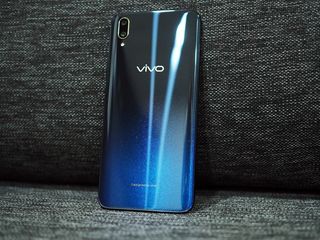Vivo V11 preview: In-display fingerprint sensor meets the 'waterdrop' notch

Vivo was the first to roll out a phone with an in-display fingerprint, and the Chinese manufacturer is now bringing the feature to its mid-range V series. The V11 is now official in Thailand and India, and will be heading to other Asian markets shortly. The phone offers considerable upgrades over the V9, which made its debut just six few months ago. Key among them is the Snapdragon 660 and a 25MP front shooter.
The biggest change on the design front is a new "waterdrop" cutout at the top of the display. The narrow notch makes it a much more palatable option, and it doesn't take away a lot of room for icons in the status bar. With the notch now housing just the front camera module, the earpiece has moved to a tiny grille located above the screen.
The V11's raison d'être is the in-display fingerprint sensor. It works just as reliably as it did on the X21 and the NEX, but it isn't quite as fast as regular fingerprint readers. It takes just under a second to authenticate using the in-display sensor, and Vivo also offers a facial unlock feature. Face unlock is considerably faster, but the caveat is that it isn't as secure as the fingerprint reader.
Vivo introduced several interesting designs in 2018, with the NEX featuring a geometric pattern at the back that changed color based on light reflecting off its surface. The V11 features a speckled design underneath the glass that's meant to evoke images of distant galaxies. The blue on black color option I'm using is called Starry Night, and the V11 also comes in a blue and purple hue called Nebula. The color shifts between various hues of blue, and the design is right up there as one of the most evocative of 2018.




There's a 3.5mm jack as well, and the audio output is particularly great for a device in this category. That said, Vivo is one of the few manufacturers that is yet to switch to USB-C. This was the case on the X21 as well, and although the NEX charged over USB-C, it looks like Vivo isn't willing to make the switch for its mid-range models. Thankfully, Vivo's fast charging tech is one of the best out there, and you'll be able to fully charge the 3400mAh battery in just under two hours.
| Specs | Vivo V11 |
|---|---|
| Screen | 6.41-inch Super AMOLED (2340x1080) |
| Chipset | Snapdragon 660 |
| RAM | 6GB |
| Storage | 128GB |
| Software | Android 8.1 Oreo, Funtouch OS 4.5 |
| Rear Camera 1 | 12MP, ƒ/1.8 |
| Rear Camera 2 | 5MP |
| Front Camera | 25MP, ƒ/2.0 |
| Security | In-display sensor, face unlock |
| Battery | 3400mAh |
| Connectivity | Wi-Fi 802.11 ac, BT5.0 |
| Colors | Starry Night, Nebula |
| Dimensions | 157.9x75x7.9mm |
| Weight | 156g |
The 6.41-inch Super AMOLED 19.5:9 display is one of the best panels you'll find in this segment, with vibrant colors and excellent contrast levels. With competition intensifying in this category, manufacturers are introducing phones with more robust hardware. Vivo was particularly notorious for rolling out devices with underpowered hardware in the past, and while it did a great job optimizing the software, its phones didn't hold up to the likes of Xiaomi, Huawei, or even Samsung in terms of value for money.
That's changing with the V11. The phone features the Snapdragon 660, a stalwart in this category. To give you a context of how just big a change this is for Vivo, the V9 — which was unveiled in March 2018 — was powered by the Snapdragon 626. As you'd imagine, the Snapdragon 660 offers a significant boost in performance, and the V11 also comes with 6GB of RAM as standard and 128GB of internal storage.
Be an expert in 5 minutes
Get the latest news from Android Central, your trusted companion in the world of Android
On the camera side of things, the Vivo V11 features a 12MP + 5MP configuration at the back and a 25MP camera up front. Like most other manufacturers, Vivo is betting on AI-assisted features to differentiate the cameras on the V11. The AI automatically analyzes a scene and selects the ideal shooting mode, and Google Lens integration is baked into the camera.
There's an AI Face Beauty mode that lets you tweak several parameters when taking selfies, ranging from removing blemishes to more extreme effects that include changing the contours of your nose, jaw, mouth, and more.
On the software side of things, the V11 comes with Funtouch OS 4.5 based on Android 8.1 Oreo. The interface borrows several elements from iOS, including a Control Center that's accessible with a swipe up from the bottom of the screen. There's no app drawer either, but you do get navigation gestures.

Overall, the Vivo V11 is a step in the right direction. The upgraded hardware allows it to go up against the Nokia 7 Plus, and unlike the V9, the phone doesn't look like an iPhone clone. There's considerable work to be done on the software side of things, but as the V11 is aimed primarily in Asian markets, it doesn't look like we'll see a lot of changes on this front anytime soon.

Harish Jonnalagadda is a Senior Editor overseeing Asia at Android Central. He leads the site's coverage of Chinese phone brands, contributing to reviews, features, and buying guides. He also writes about storage servers, audio products, and the semiconductor industry. Contact him on Twitter at @chunkynerd.